模耦合理论及应用共24页
《耦合理论》课件

有限差分法
总结词
有限差分法是一种将偏微分方程离散化 为差分方程的方法。
VS
详细描述
有限差分法通过将连续的时间和空间变量 离散化为有限个离散点,并使用差分近似 代替微分,将偏微分方程转化为离散的差 分方程组。然后,使用迭代或其他数值方 法求解该差分方程组,以获得近似解。
谱方法
总结词
谱方法是一种基于傅里叶级数或其它正交多 项式展开的数值方法。
详细描述
在电路中,耦合现象通常表现为信号的传递 和干扰。例如,变压器、电感和电容等元件 之间存在电磁耦合,这些耦合会导致信号的 传输和能量的损失。为了减小耦合效应,工 程师需要合理地设计电路布局和元件参数,
以优化电路性能。
建筑结构的耦合分析
总结词
建筑结构的耦合分析是指将结构视为一个整体,分析其各组成部分之间的相互作用和影 响。
02
根据影响和作用的范围,耦合可以分为局部耦合和全局耦合。局部耦合是指影 响和作用仅限于系统或组件的局部范围,而全局耦合则是指影响和作用遍及整 个系统或组件。
03
根据影响和作用的稳定性,耦合可以分为稳定耦合和不稳定耦合。稳定耦合是 指影响和作用在长时间内保持稳定,而不稳定耦合则是指影响和作用随时间变 化而变化。
时空耦合模型是指系统中各部分之间 的相互作用关系不仅与它们的状态变 量有关,还与时间和空间有关。
时空耦合模型在气候变化、地震预测 和城市规划等领域有广泛应用,例如 气候模式和城市交通网络等。
在时空耦合模型中,各部分之间的相 互作用力不仅与它们的状态变量成正 比,还与时间和空间有关,因此系统 状态的演化是时空相关的。
耦合的应用场景
01
在通信系统中,耦合可 以被用于描述信号传输 过程中的能量损失和干 扰现象。
第三章 模耦合理论及应用
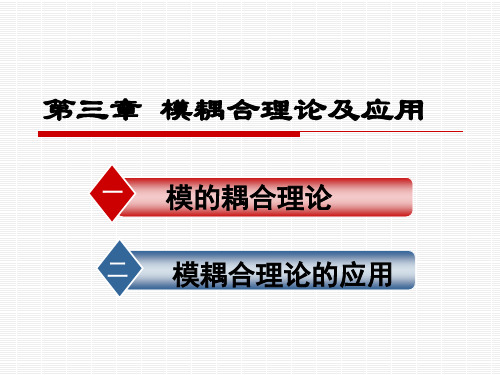
B ( z ) B e
A( z ) Ae e
e
A0 e B0 e
j 2 2 z j 2 2 z
e e
jz jz
Ae e j 2 2
2 2 z
A0
2 2
e
j 2 2 z
e
j ( b a ) z
表示两个模之间的耦合系数
表示两个模之间的相位匹配常数
3.1.1模耦合理论的基本概念—耦合方程
ab c f f b dxdy
* a II
其积分范围是波导II 的截面
C是 a , b 归一化相关常数
3.1.2模耦合理论的基本概念—同向传输
3.1.1模耦合理论的基本概念—耦合方程
模耦合的基本思想:
有波导I和 II ,当它们离得充分远时,假设其 各自的简正模场分布为φaφb ,并分别以传输 常数βa βb进行传输,然后,将两个波导相互 靠近,简正模的场分布不再是φaφb,而是将 包含波导I、II 的整个体系看作是一个波导, 此时耦合波导体系中传输的将是两个新的简正 模φeφo传输常数φe φo 此是模耦合的基本 概念。 53页给出
同方向传输耦合
55页
模型图
a〉, b〉 , a〉 b 0 0
dA( z ) j ab B( z )e j ( b a ) z 已知耦合方程: dz dB( z ) j ba A( z )e j ( b a ) z dz
* ab ba 2 a - b
3.1.2模耦合理论的基本概念—同向传输
则将模耦合方程求解得到:
A( z )
B( z ) e
耦合模理论-coupled mode theory
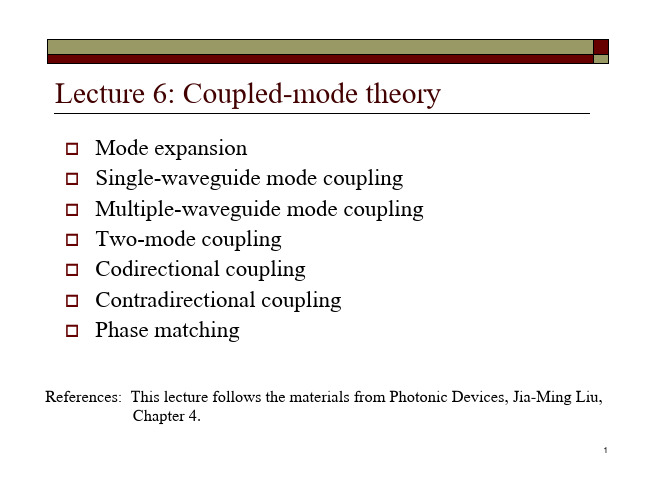
Mode expansion Single-waveguide mode coupling Multiple-waveguide mode coupling Two-mode coupling Codirectional coupling Contradirectional coupling Phase matching
References: This lecture follows the materials from Photonic Devices, Jia-Ming Liu, Chapter 4.
1
Coupled-mode theory
Coupled-mode theory deals with the coupling of spatial modes of different spatial distributions or different polarizations, or both. The normal mode fields spatial dependence in a lossless waveguide at a single frequency can be given as
ˆ ( x, y ) exp(i z ) E (r ) A ( z ) E
ˆ ( x, y ) exp(i z ) H (r ) A ( z ) H
9
Single-waveguide mode coupling
10
Single-waveguide mode coupling
E i 0 H H iE iP
光纤光栅模耦合理论
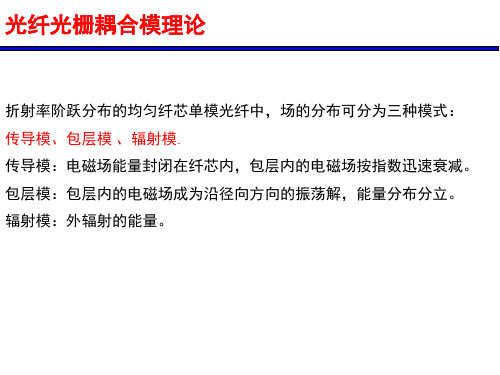
折射率阶跃分布的均匀纤芯单模光纤中,场的分布可分为三种模闭在纤芯内,包层内的电磁场按指数迅速衰减。 包层模:包层内的电磁场成为沿径向方向的振荡解,能量分布分立。
辐射模:外辐射的能量。
光纤光栅耦合模理论
当某一模式光波在光纤中传至光栅部位并满足布喇格条件时,每
1 j0
2 t Emt ) j m ( z H mt ) j 0 n0 Emt
............ ........... ...........
光纤光栅耦合模理论
各本征模均遵从麦克斯韦方程
t (
1 j0
1
2 t Emt ) j m ( z H mt ) j 0 n0 Emt
的宽度(FWHM)。
问题10:带宽
光纤光栅模式耦合理论
光纤光栅区域的光场满足模式耦合方程:
dA z z k z B z exp i q z dz dz 0 z dB z dz k z A z exp i q z dz 0
单模均匀光纤光栅反射谱公式: 光纤光栅布喇格反射公式
光纤光栅耦合模理论
光纤光栅区域的光场满足模式耦合模方程:
dAin0 dz dAin0 dz K n0 m0 Aim0 exp[ j ( n0 m0 ) z ] K n0 m0 Aim0 exp[ j ( n0 m0 ) z ]
简化方程
z dA z k z B z exp[i q z dz ] dz 0 z dB z k z A z exp[i q z dz ] dz 0
光纤光栅模耦合理论

单模均匀光纤光栅反射谱公式: 光纤光栅布喇格反射公式
光纤光栅耦合模理论
光纤光栅区域的光场满足模式耦合模方程:
dAin0 dz dAin0 dz K n0 m0 Aim0 exp[ j ( n0 m0 ) z ] K n0 m0 Aim0 exp[ j ( n0 m0 ) z ]
t Emt H mt H mz 考虑 j m H mt j0 z 是m模式的播常 H mt 2 m H m t H mz z j 0 n0 Em m zt t z
t (
A z 、B z 分别为光纤光栅区域中的前向波、后向波; k z 为耦合系数;q z 与光栅周期和传播常数 有关。
利用此方程和光纤光栅的折射率分布、结构参量及边界条件, 并借助数值算法,可以求出光纤光栅的光谱特性。
i t i 0 m i m mt i H t bi ' m H mt i ' 0 m
i i 2 t [ t (aim Emt )] z (bim H mt ) j 0 n aim Emt j0 z i0 m i0 m i0 m i
i i 2 t [ t (aim Emt )] z (bim H mt ) j 0 n aim Emt j0 z i0 m i0 m i0 m i
dbim )( z H mt ) j 0 (n 2 n0 2 )aim Emt ] 0 dz i 0 m i daim bim 1 1 {[( jb )( z E ) [( )( H i m m mt t t mt )]} 0 2 2 dz j n n i 0 m 0 0
第六章 模式耦合理论2016
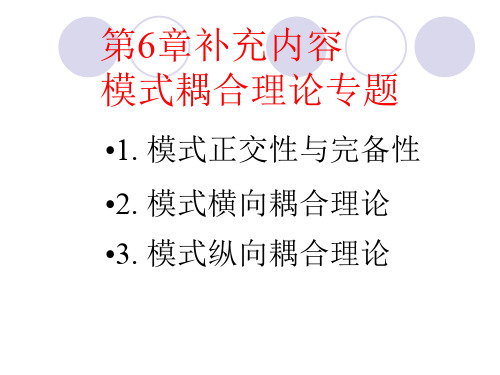
K 21
6 17
上式说明了一个有趣的现象,光波功率在光纤1和光纤2之间周期性 sin 2 Kz 1 交换(结论二),如果 ,则光功率完全耦合到光纤 2中。
(6-15)式 和(6-16)式的结果只能说是耦合模方程的形式解,因为在所 得结果中,有两个重要的参数,即耦合参数K12和K21并未给出。 严格求解这两个系数是非常困难的,简化的过程如下。 如右图示,将整个光纤耦合系 统分成三个区域。 如前所述,弱耦合条件下,可 认为波导1和波导2内的场分别为
6 9
K12 和 K 21是耦合系数,它们直接决定了光纤1和光纤2之间相互影响
的大小。一般说来,耦合系数都是复数,并且可以采用Lorentz互易 定理证明它们具有如下互易特性
* K12 K 21
利用 (6-8)式和耦合方程(6-9)式,可以得到
dA1 z j z jK 21 A2 z e 1 2 dz dA2 z jK A z e j 2 1 z 12 1 dz
K 21 1 B a 1 2 1 K a2 B 1 a K 21 a 2 2 1 2 K
6 9
6 14
a2 0 如果再令初始条件 ,则可将上式简化为
j z a1 z a1 cos Kze j z a2 z a1 sin Kze
•2. 模式的横向耦合理论
到另一根光纤中光波场的影响。 为分析两根相互靠近的光纤 的影响,首先假设两根光纤单独 存在时的场量分别为 a.)只有波导1存在时
1 j z E10 e 1 E1 2 j z 1 E10 e 1 j z H10 e 1 H1 2 j z 1 H10 e
model coupling theory

model coupling theory模型耦合理论(Model Coupling Theory)是指将不同的模型或子模型通过某种方式相互连接,形成一个整体模型的理论和方法。
它旨在解决多个模型之间相互依赖、相互影响的问题,以及提高模型的准确性和可靠性。
模型耦合理论的基本思想是将多个模型组合成一个整体模型,使得各个子模型之间可以相互传递信息、相互影响,并通过协同作用达到更准确的结果。
模型耦合可以是线性的、非线性的,也可以是静态的、动态的。
在模型耦合理论中,常用的耦合方式有以下几种:1. 驱动-响应耦合(Driver-Response Coupling):一个模型作为主模型,驱动其他模型的运行,并根据其他模型的响应进行调整。
这种耦合方式常用于模拟系统的控制过程。
2. 数据耦合(Data Coupling):不同模型之间通过共享数据进行耦合。
模型之间的数据交换可以是单向的或双向的,可以是离散的或连续的。
3. 参数耦合(Parameter Coupling):不同模型之间通过共享参数进行耦合。
一个模型的输出可以作为另一个模型的输入参数,或者两个模型共享相同的参数。
4. 接口耦合(Interface Coupling):不同模型之间通过定义共同的接口进行耦合。
接口定义了模型之间的输入和输出,使得模型之间可以进行交互。
模型耦合理论的应用非常广泛,包括气候模型、生态模型、经济模型等领域。
通过将不同的模型耦合起来,可以更好地模拟和预测复杂系统的行为,提高决策的科学性和准确性。
然而,模型耦合也带来了一些挑战,如模型之间的数据一致性、模型之间的计算效率等问题,需要进一步研究和解决。
第三章 模耦合理论及应用3、2
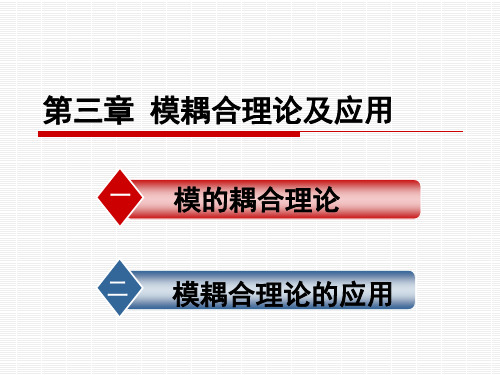
§3.2 模耦合理论的应用—光纤定向耦合器
制作方法: 2×2定向耦合器大多采用熔融 拉锥的制造方法,在制作过程中,将两根光 纤胶合在一起,用火焰加热到软化温度后再 拉伸,在熔融区形成渐变双锥结构,拉锥后, 一方面两光纤彼此靠近,另一方面光纤芯径 减小,从而使光场由纤芯向外扩散,纤芯外 的场称为消失场。当两光纤极为靠近时,将 会通过消失场进行能量交换,产生两光纤之 间的耦合,耦合的程度取决于耦合区长度及 纤芯间包层的厚度。
2 (n12 k 02 k x2 k y )1 / 2 2 p x [(n12 n2 )k 02 k x2 ]1 / 2 2 2 p y [(n12 n2 )k 02 k y ]1 / 2 2 2 q y [(n12 n3 )k 02 k y ]1 / 2
1/ 2
, 2 1 2
§3.2 模耦合理论的应用—光纤定向耦合器
若耦合的两根光纤完全一致,且耦合的两模式相 位匹配,则可以得到两输出光场振幅及功率的表 达式 :
A( z ) A0 cos( z )
2
B( z ) iB0 sin( z )
2 p1 ( z ) A( z ) A0 cos2 ( z )
2 x
§3.2 模耦合理论的应用—矩形定向耦合器
举例: 设矩形波导定向耦合器的参数
n1 1.5, n2 1,515, n3 1,2a 5m,2b 1m,2c 1m, 632.8nm
可求得: kc 4cm1 ,即得耦合长度 LC / 2kc 3.9nm 由于耦合系数随 2c 的增大而指数式减小,所以间距 2c 发生微小变化, 可以影响耦合长度很大的变化. 例如: 上式中, Lc / 2c 7000,因此 间距 2c 发生 100nm 偏差将使耦合 长度 LC 改变 20% ,( Lc =0.7mm) 所以说明在制作给定耦合长度为
耦合模理论的推导公式
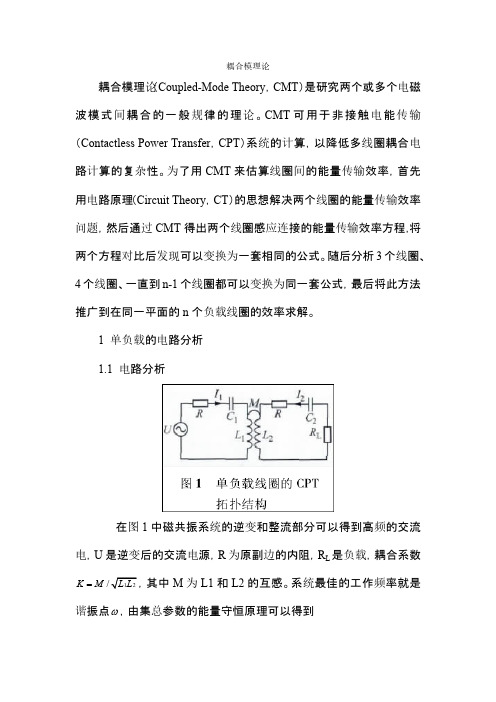
CMT 可得
a1(t) (j 1)a1(t) jK 12a2(t) FS(t) a2(t) (j 2 1)a2(t) jK 12a1(t)
(6) (7)
在上述公式中, 1, 2, L 分别为原线圈的损耗、负载线圈的损耗和
负载的吸收功率, K12 为两个线圈的耦合率, FS(t) 为励磁损耗(忽略不
所带的负载, K 2 和 K 3 分别为两个负载线圈的耦合系数.同理可得
U
R
j
L1
1 C
1
I
1
jM 2I 2
jM 3I 3
(10)
0
R
RL2
j
L
2
1 C
2
I
2
jM 2I 1
(11)
0
R
RL3
j
L
3
1 C 3
I
3
jM 3I 1
(12)
在谐振状态下的传输效率为
CT
P
I R 2 2 L2
在谐振状态下,
0
L1
1 0L1
,
L0 2
1 0L2
,
X
1
R,
X
2
R
,从而得到
CT
((RL
2M 2 RL R)R 2M 2 )(RL
R)
(5)
1.2 CMT 分析
CPT 系统中,常常只涉及稳态分析,在此也仅分析稳态特性。主
线圈的幅值在正弦时为一个常数;同理,次线圈的幅值也是一个常数, 两个时间域线圈 a1(t), a2(t) 的原始储能可分别表示为 a1(t) 2 , a2(t) 2 。由
( L 2)(( L 2)1 K 122
耦合模理论
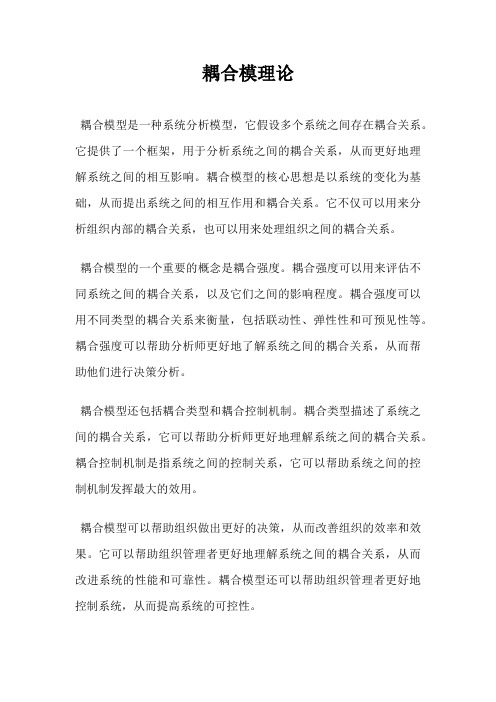
耦合模理论
耦合模型是一种系统分析模型,它假设多个系统之间存在耦合关系。
它提供了一个框架,用于分析系统之间的耦合关系,从而更好地理解系统之间的相互影响。
耦合模型的核心思想是以系统的变化为基础,从而提出系统之间的相互作用和耦合关系。
它不仅可以用来分析组织内部的耦合关系,也可以用来处理组织之间的耦合关系。
耦合模型的一个重要的概念是耦合强度。
耦合强度可以用来评估不同系统之间的耦合关系,以及它们之间的影响程度。
耦合强度可以用不同类型的耦合关系来衡量,包括联动性、弹性性和可预见性等。
耦合强度可以帮助分析师更好地了解系统之间的耦合关系,从而帮助他们进行决策分析。
耦合模型还包括耦合类型和耦合控制机制。
耦合类型描述了系统之间的耦合关系,它可以帮助分析师更好地理解系统之间的耦合关系。
耦合控制机制是指系统之间的控制关系,它可以帮助系统之间的控制机制发挥最大的效用。
耦合模型可以帮助组织做出更好的决策,从而改善组织的效率和效果。
它可以帮助组织管理者更好地理解系统之间的耦合关系,从而改进系统的性能和可靠性。
耦合模型还可以帮助组织管理者更好地控制系统,从而提高系统的可控性。
综上所述,耦合模型是一种系统分析模型,它可以帮助组织更好地理解系统之间的耦合关系,从而改善组织的效率和效果。
它可以帮助组织管理者更好地理解系统之间的耦合关系,从而改进系统的性能和可靠性。
它还可以帮助组织管理者更好地控制系统,从而提高系统的可控性。
六、耦合理论

a2
6 14
则由 (6-13)式和耦合方程(6-14)式,可以得到
a1
z
A1
z
e j1z
1 2
a1
k21 k12
a2
e
j Kz
1 2
a1
k21 k12
a2
e
j
K
z
a2
•1. 模式正交性与完备性 •2. 模式横向耦合理论 •3. 模式纵向耦合理论
•1. 模式的完备性与正交性
前几节中,分别用几何光学方法和电磁理论方法分析了光纤中 的电磁波传播问题。用电磁理论方法求解时,建立的一个重要的要 概念是模式,分别讨论了电磁导波模式的两种不同表达方式,即矢 量模和标量模。这种理想的光波导的导波模式满足边界条件,被称 为正规模。正规模满足模式的正交性和完备性。
E2
E10e
j2z ; H2
H10e
j2z
则耦合波的形式为
6 6
其中
E a1 z E10 a2 z E20
H
a1 z
H10
a2
z H20
6 7
a1 z A1 z e j1z
a2
E1 a1zE10 H1 a1zH10 E2 a2 zE20 H2 a2 zH20
波导1 波导2
D1
D3
n1 n3
D2
n2
两根互相平行的光波导
根据电磁波的传播理论,光纤1中的电场会在周围激励起磁场, 磁场也会在周围激励起电场。由麦克斯韦方程,可知光纤1周围有
开题报告光纤耦合模理论
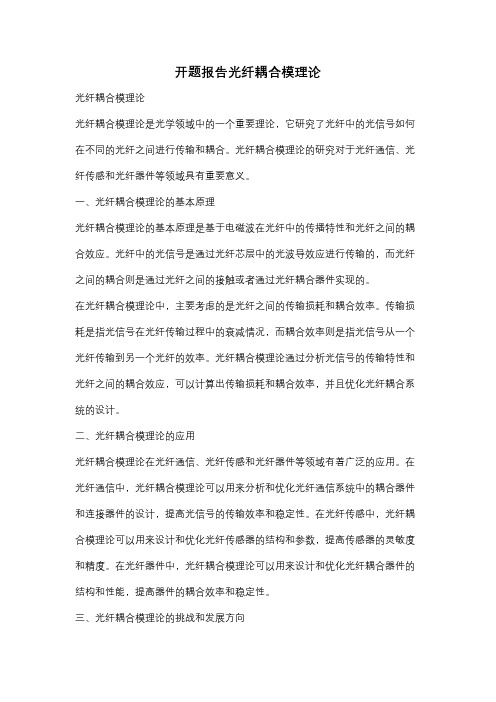
开题报告光纤耦合模理论光纤耦合模理论光纤耦合模理论是光学领域中的一个重要理论,它研究了光纤中的光信号如何在不同的光纤之间进行传输和耦合。
光纤耦合模理论的研究对于光纤通信、光纤传感和光纤器件等领域具有重要意义。
一、光纤耦合模理论的基本原理光纤耦合模理论的基本原理是基于电磁波在光纤中的传播特性和光纤之间的耦合效应。
光纤中的光信号是通过光纤芯层中的光波导效应进行传输的,而光纤之间的耦合则是通过光纤之间的接触或者通过光纤耦合器件实现的。
在光纤耦合模理论中,主要考虑的是光纤之间的传输损耗和耦合效率。
传输损耗是指光信号在光纤传输过程中的衰减情况,而耦合效率则是指光信号从一个光纤传输到另一个光纤的效率。
光纤耦合模理论通过分析光信号的传输特性和光纤之间的耦合效应,可以计算出传输损耗和耦合效率,并且优化光纤耦合系统的设计。
二、光纤耦合模理论的应用光纤耦合模理论在光纤通信、光纤传感和光纤器件等领域有着广泛的应用。
在光纤通信中,光纤耦合模理论可以用来分析和优化光纤通信系统中的耦合器件和连接器件的设计,提高光信号的传输效率和稳定性。
在光纤传感中,光纤耦合模理论可以用来设计和优化光纤传感器的结构和参数,提高传感器的灵敏度和精度。
在光纤器件中,光纤耦合模理论可以用来设计和优化光纤耦合器件的结构和性能,提高器件的耦合效率和稳定性。
三、光纤耦合模理论的挑战和发展方向尽管光纤耦合模理论在光学领域中有着广泛的应用,但是仍然存在一些挑战和需要进一步研究的问题。
首先,光纤耦合模理论需要考虑光纤中的非线性效应和衍射效应等因素,以更准确地描述光信号的传输和耦合过程。
其次,光纤耦合模理论需要考虑光纤之间的距离和角度等因素对耦合效率的影响,以优化光纤耦合系统的设计。
此外,随着光纤通信和光纤传感技术的发展,光纤耦合模理论也需要适应新的应用场景和需求,例如在高速光纤通信和微纳光纤传感中的应用。
未来的发展方向是进一步提高光纤耦合模理论的计算和仿真能力,以更准确地预测和优化光纤耦合系统的性能。
耦合过程及其多尺度行为的理论与应用研究
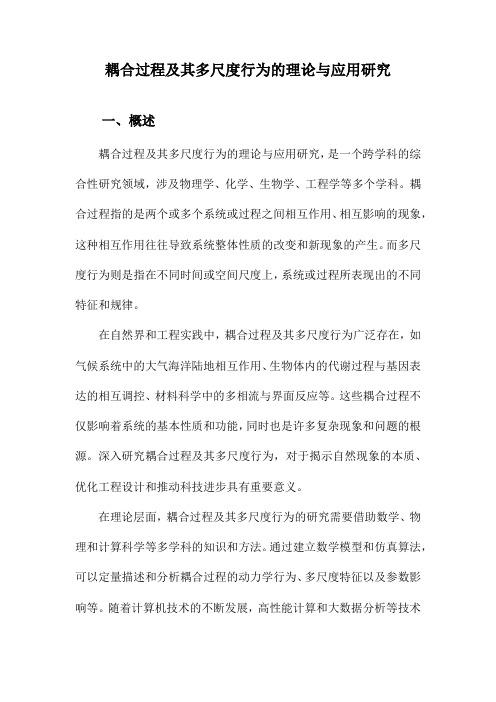
耦合过程及其多尺度行为的理论与应用研究一、概述耦合过程及其多尺度行为的理论与应用研究,是一个跨学科的综合性研究领域,涉及物理学、化学、生物学、工程学等多个学科。
耦合过程指的是两个或多个系统或过程之间相互作用、相互影响的现象,这种相互作用往往导致系统整体性质的改变和新现象的产生。
而多尺度行为则是指在不同时间或空间尺度上,系统或过程所表现出的不同特征和规律。
在自然界和工程实践中,耦合过程及其多尺度行为广泛存在,如气候系统中的大气海洋陆地相互作用、生物体内的代谢过程与基因表达的相互调控、材料科学中的多相流与界面反应等。
这些耦合过程不仅影响着系统的基本性质和功能,同时也是许多复杂现象和问题的根源。
深入研究耦合过程及其多尺度行为,对于揭示自然现象的本质、优化工程设计和推动科技进步具有重要意义。
在理论层面,耦合过程及其多尺度行为的研究需要借助数学、物理和计算科学等多学科的知识和方法。
通过建立数学模型和仿真算法,可以定量描述和分析耦合过程的动力学行为、多尺度特征以及参数影响等。
随着计算机技术的不断发展,高性能计算和大数据分析等技术的应用也为耦合过程的研究提供了新的手段和可能性。
在应用层面,耦合过程及其多尺度行为的研究成果在多个领域具有广泛的应用前景。
在气候预测和环境保护中,可以通过研究大气海洋陆地等系统的耦合过程来预测极端天气和制定减排策略在生物医学工程中,可以利用多尺度模拟和优化方法来设计更高效的药物和医疗器械在材料科学和能源领域,可以通过研究材料的多尺度结构和性能关系来开发新型材料和提高能源利用效率。
耦合过程及其多尺度行为的理论与应用研究是一个充满挑战和机遇的研究领域。
通过深入探索和理解耦合过程的本质和规律,我们可以为自然现象的解释、工程设计的优化以及科技进步的推动提供有力的理论支撑和实践指导。
1. 耦合过程的概念与定义作为一种广泛存在于物理、生物、社会等系统中的现象,是指两个或多个系统、部分或元素之间存在的相互作用、相互关联以及能量或信息交换的过程。
耦合模理论
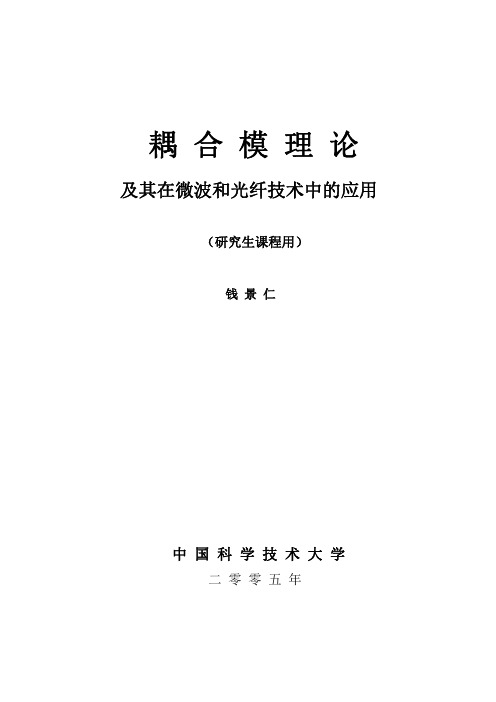
耦合模理论及其在微波和光纤技术中的应用(研究生课程用)钱景仁中国科学技术大学二零零五年目录绪言 (Preface) (1)第一章耦合模的一般理论§1.1 耦合模方程 (6)§1.2 强耦合与弱耦合 (11)§1.3 周期性耦合 (18)§1.4 耦合模与简正模 (29)§1.5 缓变参数情况下本地简正模广义理论 (33)§1.6 理想模、本地简正模和超本地简正模 (37)§1.7 耦合器应用举例 (42)§1.8 临界界面附近和稳相点附近的耦合模方程 (46)第二章闭合波导中的耦合模问题§2.1 介质填充波导 (51)§2.2 缓变表面阻抗和阻抗微扰 (59)§2.3 弯曲波导 (64)第三章光纤中的耦合模问题§3.1 光纤中的简正模式 (68)§3.2 耦合模理论的推广 (80)§3.3 非理想光纤的耦合模方程 (81)§3.4 用闭合波导理论来研究开波导 (86)第四章 螺旋光纤及弯曲光纤§4.1 螺旋光纤的耦合模分析 (89)§4.2 单模传输条件下的螺旋光纤 (93)§4.3 弯曲光纤 (98)第五章耦合功率方程§5.1多模波导和多模光纤的传输特性 (104)§5.2 多模波导中的耦合功率方程 (105)§5.3 多模光纤传输中的耦合功率方程 (107)中文参考文献 (109)英文参考文献 (110)PrefaceWhat is the coupled-mode theory? Is it a common theory in physics?Waves and vibration phenomena are popular in physics as we know such as mechanical vibrations, acoustic waves, light waves, microwaves and radio waves. Furthermore, connection or coupling among systems is also a general rule in universe. Everything presupposes the existence of some other thing. Cause-effect relations and action-reaction relations are generally existed among systems in the universe.It is obvious that there aren’t any ideal waves which exist independently and do not change their amplitudes and directions. A real wave or vibration is always connected with a source or other waves. Now, it is necessary to describe how these waves or vibrations (oscillations) couple to each other, and how their amplitudes change with the time or the distance. To illustrate the principle of the coupling between waves or vibrations (oscillations), let’s take pendulums as an example.Fig. aA pendulum can vibrate, that is to say it swings from side to side. We can give it a push and then it will vibrate at a fixed speed or at a certain frequency. If two pendulums with same frequency are hung on a string and one of them is set swinging as shown in Fig. a, it will swing less and less until it stops altogether, while the other pendulum will swing higher and higher until it reaches a maximum. Then the process will be reversed until the first pendulum reaches a maximum and the second comes torest once more. This cycle repeats itself again and again. It would repeat infinitely ifthere were no losses in the system.This is a typical experiment performed in most early physics courses. I had done it when I was in middle school.1Fig. b Frequencies are the same. Fig. c Frequencies are different.If these two pendulums have different frequencies, then transfer of energy between them will not be complete, and the first pendulum will not stop in the process. We can plot a graph to express the process as shown in Fig.b and Fig.c. The abscissa represents the time, and the ordinate A represents the amplitude of each pendulum. If the initial conditions at t =0 are as follows:()()1201,00A A ==,We can see the variations of the amplitudes of the two coupled pendulums in Fig.b and Fig.c, respectively, when their frequencies are the same and different. The time spacing between two adjacent maxima (or minima) is the period of the process, which is determined by the coupling between the two pendulums. The stronger the coupling is, the shorter the period is. The coupling between the two pendulums is caused by the fact that the pendulums are connected to a same string, and any vibration of one of the pendulums will have an effect on the other through the string.It has been recognized that coupled transmission lines, coupled electrical circuits, coupled optical fibers and coupled waveguides are analogous to coupled pendulums. The variations of the amplitudes of waves are the same as shown in the figures, but now the abscissa represents distance instant of time.Sometimes the coupling is not between the same kind of waves or oscillations, for example, in a traveling wave tube, a space-charge wave and an electromagnetic wavecouple to each other. In a crystal, an electrical vibration will cause a mechanical (or acoustic) vibration and vice versa.There should be some general rules or there is a generalized theory to describe these coupling problems. It is the so called coupled-mode theory. Here, mode means one of the models of wave forms.In the theory, all the coupled-mode or coupled-vibration problems are formulated by a set of coupled-mode equations, which are simultaneous differential equations of first order with variable or constant coefficients. In case of two modes, they can be written as follows:()()()()()()11122221j j j j dA z A z cA z dz dA z A z cA z dz ββ=−+=−+Where i β and c are functions of z in general case.When n modes or waves should be considered in a coupling problem, n differential equations will be used instead of two.A common method in electromagnetic theory is the modal approach in which the normal modes of the system (those fields which propagate unchanged except in phase) are found. This involves solving the wave equation adapted to the particular geometry of the system, and matching solutions at the boundaries to give the normal modes or eigensolutions. Any field of the system can then be expanded in terms of the normal modes, with the expansion coefficients determined by certain boundary conditions e.g. initial conditions. This modal-expansion or eigenvector method is physically intuitive and straightforward in principle, but modal solutions of the wave equation can only be found for a limited number of ideal systems of relatively simple geometry, including slabs and circular cylinders.Coupled-mode theory attempts to preserve the concept of modes for non-ideal systems in which an exact modal solution is not possible but where the normal modes of a reference system of simple geometry are known. These modes, in general, form a complete set so that they can be used to expand the fields of the non-ideal system.Because they do not satisfy the boundary conditions of the non-ideal system, the modes coupled or exchange power as they propagate. To derive the coupled-mode equations, Maxwell’s equations are transformed to those which determine how the individual mode amplitudes vary as a function of the parameters of the system. There have been several methods of coupled-mode analysis to formulate the coupled-mode equations. In the early times, people used to start directly from Maxwell’s equations along with the boundary conditions to derive these equations. Later, many other methods were utilized, such as using reciprocity theorem, starting from a Green function or stimulating equations of waveguides, someone also used variation method and perturbation approach, all these are substantial agreement.The method of coupled-modes is most useful when the deviation of the non-ideal system from the known reference system is not too great e.g. small deviations in refractive index or small deformation of cross-section. Although the imperfections may be small they can still produce marked effects, such as total transfer of power from one mode to the other in a waveguide or one waveguide to another. Coupled-mode theory has also been used to treat a variety of problems, including the cross-sectional deformation of waveguides. In many of the problems where the power transfer between modes is small, solutions can also be obtained by other techniques. However, coupled-mode theory has particular application to systems in which a large fraction of modal power may be transferred to other modes, as in the case of neighbouring waveguides in which complete transfer of power between waveguides can take place. This is unique for coupled-mode theory.The primary idea of the coupled-mode theory was first introduced by Pierce in 1940’s, when he worked on microwave electronic devices. Later, this idea was extended its use to the waveguide transmission by Miller and then the theory was fully developed. Recently, the theory has been widely used to solve optical fiber transmission problems and fiber gratings. On the other hand, the coupled-mode theory supervises the practice and many new coupling principles have been discovered. According them, a variety of devices have been designed, such as mode transducers, broadband optical fiber couplers and etc.A lot of coupling problems involving optics, acoustics and microwaves have been being solved by scientists of many countries, including Chinese scientists. Prof. Huang Hong-Chia, vice-president of Shanghai University, has made important contributions to coupled-mode theory. Some of his papers are listed in the end of this book for reference.In this book, the first chapter begins with the coupled-mode equations and is followed by many treatments to solve these equations. In Chapter 2, many typical coupled-mode problems in closed waveguides are solved. Those all problems will lead to the coupled-mode equations and then the coupling coefficients are derived. Chapter 3 begins with a discussion of the normal modes in optical fibers. The remainder of the chapter deals with coupling between these normal modes in imperfect optical fibers. In Chapter 4 helical fibers and bending fibers are studied. In the fifth chapter the coupled power theory is introduced, it consists of Pierce’s theory and Marcuse’s theory which are used in waveguide and optical fiber transmission, respectively.On the whole, coupled-mode theory is a general theory. Mathematically, it bases on the expansion theorem of eigen-functions, the existence of expansion in terms of eigen-functions makes the theory to be carried out. The mathematic areas in the theory are differential equations and linear algebra.第一章 耦合模的一般理论在这一章中,将首先从一般概念出发,得到耦合模方程。
耦合模理论的应用
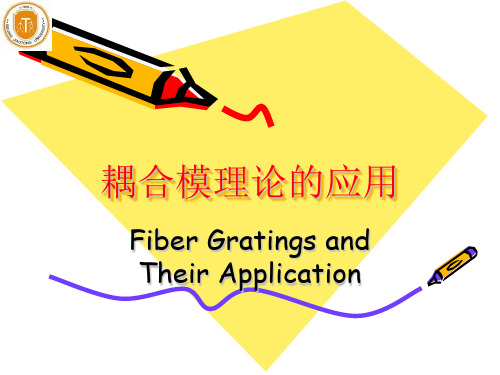
自组织光栅写入
光纤光栅的写入1——全息法 Interference Pattern Technique
写入光栅 的周期=干 涉条纹的 距离
光纤光栅的写入2—相位掩 模法 Phase Mask Technique
写入光栅的周 期=掩模版周期 的1/2
光纤光栅写入监测
宽带 光源 ASE 光谱议
OSA
Single mode fibre
Regions with higher refractive index than that of core’s
自组织光纤光栅
• 1978,K.O.Hill,加拿大渥太华研究中 心 发现光纤的光敏性。 • 位于波峰位置处的光纤芯区折射率在光 的作用下发生了永久的增加从而使纤芯 区呈现出周期性的折射率调制形成轴向 布喇格光栅
分为强度型相位型波长型波长精度加工工艺简单复杂较复杂成本较低技术成熟性成熟较成熟成熟可否分布测量可以嵌入性兼容性可以较难很好线性度一般一般很好变形能力性能稳定较好较好信号解调设备简单复杂复杂温度0014nm温度传感光纤光栅封装负温度系数材料土木结构建筑航空石油交通等温度测量光纤光栅应变特性2n2n应力作用的形变n弹光效应122pmu土木结构建筑航空石油交通等应变测量泥石流预警系统防护墙断裂探测与预防液体溢出和渗流的预警和探测储油罐液位和容量监测
宁提纲,赵玉成,魏道平,简水生“光纤光栅的紫外写入及其在 光通信中的应用”光纤与电缆及其应用技术 99年第5期 pp.43~48 K. O. Hill, Y. Fuji, D. C. Johnson, et.al “Photosensitivity in optical fiber waveguides: application to reflection filter
国家奖-耦合多场及非椭球 Eshelby 理论和应用

one that scientists all over the to do to derive a theory that is
ewxoprllidcith,aa。dndnoytebt eceann
able take
into-account of the influence of the inclusion shap,
代表性第三方评价
罗格斯大学(Rutgers University )终身教授, 国际著名力学杂志Acta Mechanica 杂志主编 ASME Journal of Engineering Materials and Technology杂志前任主编
George J. Weng
The problem Dr. Du has solved was an outstanding
科学发现及创新(I)
11 含椭球夹杂压电材料中力电耦合场解析解
耦合电场与力场解?
压电材料I
压电材料II
证明了当外加均匀的;
求得了含椭球压电夹杂的压电体中内部电场和力场分布的解析表达式; 首次严格导出了压电复合材料有效性能的预报公式。
I kl
1 jl
ElI
)
EI
E0
1
4
Ni2j (Ci1j
I
e1 mij
EmI
)
1
4
N3
j
(e1jkl
I kl
1 jl
ElI
)
夹杂外侧
科学发现及创新(II)
22 含裂纹的压电材料中三维力电耦合场解析解及其拓展
首次求得三维裂纹尖端力电强度因子; 发现并证明了裂纹尖端力场和电场呈~r-1/2的奇异性; 建立了含裂纹压电材料的断裂准则。
模耦合理论及应用PPT共24页

11、战争满足了,或曾经满足过人的 好斗的 本能, 但它同 时还满 足了人 对掠夺 ,破坏 以及残 酷的纪 律和专 制力的 欲望。 ——查·埃利奥 特 12、不应把纪律仅仅看成教育的手段 。纪律 是教育 过程的 结果, 首先是 学生集 体表现 在一切 生活领 域—— 生产、 日常生 活、学 校、文 化等领 域中努 力的结 果。— —马卡 连柯(名 言网)
51、 天 下 之 事 常成 于困约 ,而败 于奢靡 。——陆 游 52、 生 命 不 等 于是呼 吸,生 命是活 动。——卢 梭
53、 伟 大 的 事 业,需 要决心 ,能力 ,组织 和责任 感。 ——易 卜 生 54、 唯 书 籍 不 朽。——乔 特
55、 为 中 华 之 崛起而 读书。 ——周 恩来
13、遵守纪律的风气的培养,只有领 导者本 身在这 方面以 身作则 才能收 到成效 。—— 马卡连 柯 14、劳动者的组织性、纪律性、坚毅 精神以 及同全 世界劳 动者的 团结一 致,是 取得最 后胜利 的保证 。—— 列宁 摘自名言网
15、机会是不守纪律的。
耦合技术的原理和应用
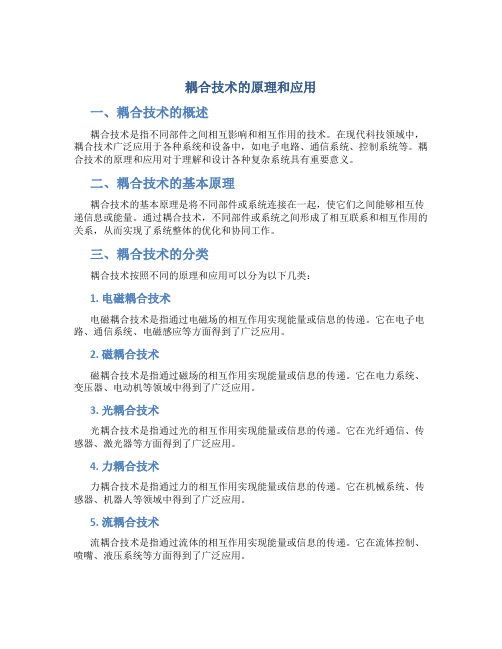
耦合技术的原理和应用一、耦合技术的概述耦合技术是指不同部件之间相互影响和相互作用的技术。
在现代科技领域中,耦合技术广泛应用于各种系统和设备中,如电子电路、通信系统、控制系统等。
耦合技术的原理和应用对于理解和设计各种复杂系统具有重要意义。
二、耦合技术的基本原理耦合技术的基本原理是将不同部件或系统连接在一起,使它们之间能够相互传递信息或能量。
通过耦合技术,不同部件或系统之间形成了相互联系和相互作用的关系,从而实现了系统整体的优化和协同工作。
三、耦合技术的分类耦合技术按照不同的原理和应用可以分为以下几类:1. 电磁耦合技术电磁耦合技术是指通过电磁场的相互作用实现能量或信息的传递。
它在电子电路、通信系统、电磁感应等方面得到了广泛应用。
2. 磁耦合技术磁耦合技术是指通过磁场的相互作用实现能量或信息的传递。
它在电力系统、变压器、电动机等领域中得到了广泛应用。
3. 光耦合技术光耦合技术是指通过光的相互作用实现能量或信息的传递。
它在光纤通信、传感器、激光器等方面得到了广泛应用。
4. 力耦合技术力耦合技术是指通过力的相互作用实现能量或信息的传递。
它在机械系统、传感器、机器人等领域中得到了广泛应用。
5. 流耦合技术流耦合技术是指通过流体的相互作用实现能量或信息的传递。
它在流体控制、喷嘴、液压系统等方面得到了广泛应用。
四、耦合技术的应用领域耦合技术的应用领域非常广泛,下面列举了一些常见的应用领域:•电子电路设计:通过耦合技术可以实现电路的信号传输、滤波、放大等功能。
•通信系统:通过耦合技术可以实现信号的传输和接收。
•控制系统:通过耦合技术可以实现系统的自动控制和反馈。
•电力系统:通过耦合技术可以实现电能的传输和分配。
•传感器技术:通过耦合技术可以实现传感器的信号采集和处理。
•光纤通信:耦合技术在光纤通信技术中起到了重要作用。
•生物医学工程:通过耦合技术可以实现医学设备的监测和治疗。
五、耦合技术的优势和挑战1. 优势•耦合技术可以实现不同部件或系统之间的协同工作,提高整体性能。
